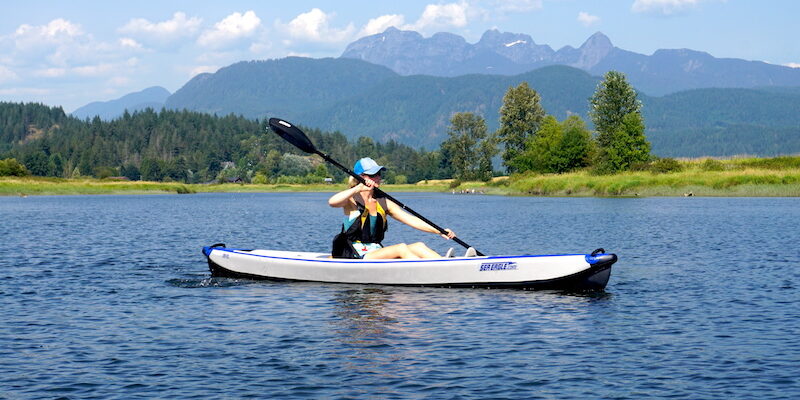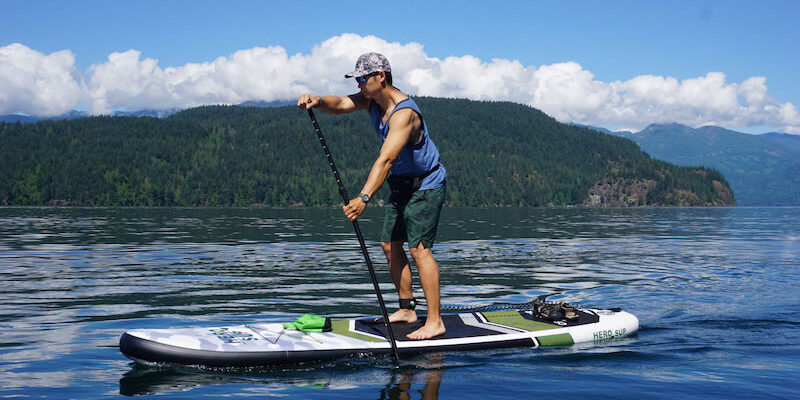The two most well known inflatable kayak materials are PVC and Hypalon. There is also a newer material being used now called Nitrylon.
Each has their positives and negatives and many people have opposing view points on which is the best to use (with regards to inflatable kayaks and other inflatable boats).
They are used because they are all extremely rugged and durable, though some better than others.
It may not affect your choice of which inflatable kayak to purchase but it is interesting to understand the difference between these materials.
What is PVC?
PVC is the abbreviation for Polyvinyl Chloride. Wikipedia describes PVC as:
“…It is a vinyl polymer consisting of vinyl groups (ethenyls) that are bound to chlorine. PVC is the third most widely produced plastic,…
Over 50% of PVC manufactured is used in construction because it is cheap, durable, and easy to assemble. PVC production is expected to exceed 40 million tons by 2016.
It can be made softer and more flexible by the addition of plasticizers, the most widely used being phtalates. …
It is also commonly used in figuring and inflatable products such as waterbeds, pool toys, and inflatable structures.”
PVC Features:
- Maximizes durability, portability and convenience of many products
- PVC-coated fabrics come in a larger array of colors than Hypalon or neoprene coated fabrics
- With reasonable care PVC will last a very long time
- PVC is cheaper than Hypalon
- PVC can be welded (allows for more solid construction – as opposed to just using glue)
- PVC is easy to patch
- Used as coating on polyester or nylon to increase the strength and tear resistance
Negatives of PVC:
- PVC is not as resistant to chemicals, gasoline, temperatures, abrasions and sunlight as Hypalon-coated fabrics – though some PVC fabrics are strengthened to be more cold resistant.
- UV rays can be damaging to PVC – with an inflatable boat you will need to use a UV protectant spray
What is Hypalon?
Hypalon is a synthetic rubber that is patented by DuPont. Wikipedia describes Hypalon as:
“… it is noted for its resistance to chemicals, temperature extremes, and ultraviolet light. … Along with PVC, it is one of the most common materials used to make inflatable boats and folding kayaks. It is also used in roofing materials.”
Hypalon Features:
PVC coated inflatable kayak
- Hypalon will last the longest out of any other inflatable kayak material
- Has better UV resistance
- Is very resistant to environmental factors like mildew and fungus
- Chosen by many inflatable boat manufacturers as an exterior coating (then will usually use neoprene to coat the interior side of the boat – neoprene has excellent air holding capabilities and oil resistance)
- **Hypalon coated onto polyester or nylon fabric which also has an interior coating of neoprene is known as the most reliable and durable inflatable boat fabric available – usually you will see boats that use these materials have warranties of 5 to 10 years
- Hypalon coated boats are used by the U.S. Military and Coast Guard
Negatives of Hypalon:
- Hypalon is more expensive than many other materials
- Hypalon is glued as opposed to welded
What is Nitrylon?
Since there has been much controversy over the harmful effects that PVC has on the environment, some inflatable boat manufacturers (such as Innova Kayaks) have begun phasing out the use of PVC and using a much more eco-friendly material, Nitrylon instead.
Nitrylon is a lamination of nitrile synthetic rubber and natural rubber over a 1200-denier, low stretch polyester fabric.
Nitrylon Features:
- Very puncture and abrasion resistant
- Stronger than PVC
- Easier to patch than PVC
- Performs better in cold weather
Negatives of Nitrylon:
- Nitrylon can be heavy so usually it is only used on the outer chambers of the boat where there will be the most wear and tear
Final Thoughts on the Different Inflatable Kayak Materials
Amazingly there is really a fair amount of controversy over the different types of materials used in the construction of inflatable kayaks and inflatable boats.
I have personally never had a problem with the PVC material but I do understand the strengths that the other materials offer.
Also like so many others I am concerned about our environment and I very much like the idea of using a material that is not harmful to our world or to our own health.
It will be interesting to see the progress in the years to come with regards to inflatable kayak materials.
Hopefully this article will clear up for many people just exactly what the difference is between the different types of inflatable boat materials.
View our comprehensive inflatable kayak reviews.
OR read more kayaking tips and advice.


My hypalon kayak is 25 years old and still is as good as new,ie; no patches or obvious wear.It will be handed down to the next generation someday.Does the longevity of this kayak offset the environmental cost of producing it especially if it outlasts several pvc or nitrile boats? Just curious.Thanks
Wow that is seriously impressive. 25 years is a long time for an inflatable to hold up. I would think that yes it would kind of offset the environmental cost in a way. If it can last that long that would mean less turnover in the market and less boats ending up at landfills.
I am planning a month long float trip in Alaska. I want to bring repair patches and adhesive for my Innova Vagabond. It uses Nitrylon in its construction. Can anyone tell me what adhesive I should buy to patch the canoe if needed? Thanks for thinking about this. Tod
Polurethane is missing here. If out performs all three menthioned materials. It has the best strength to weight ratio – great tear and abrasion resistance
Do you know if there is a list of manufactders that use the different materials for thier boats? Also as well as strength considerations, the weight of the material would affect the portability of the craft (an important factor with inflateable kayaks). How does the weight compare between the different options?
Adam
Hi Adam, excellent questions…
I did a little research but couldn’t find anywhere that listed the different materials used for the different manufacturers so I compiled a basic little list myself…
Advanced Elements, Aire, Airis, Bic, Coleman, Sea Eagle, Sevylor, Tributary and Stearns all use PVC.
Innova uses Nitrylon – for most of their kayaks,
and NRS uses Hypalon for some of their models.
As far as the weight considerations I really don’t know how the weight differs between the different materials and can’t seem to find anyone who can say for sure. However I do know that the weight can vary greatly depending on the make and model of the kayak, the seams, valves, accessories, etc. as well as whether nylon or polyester are used. Also the thickness of the denier will greatly affect the weight. Typically the higher the denier the stronger the fabric and the more rigid the inflatable kayak… it can also mean a heavier boat.
If you ever happen to find exactly which material weighs more, I would love to know as well. Hope this helps a little, thanks for your questions!
Cheers, Allison